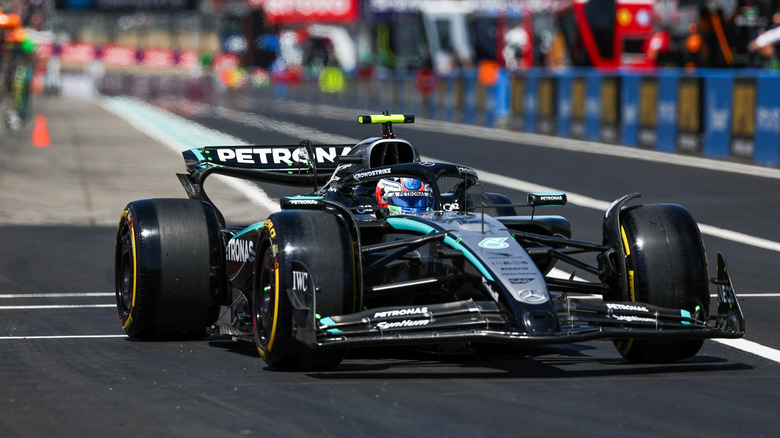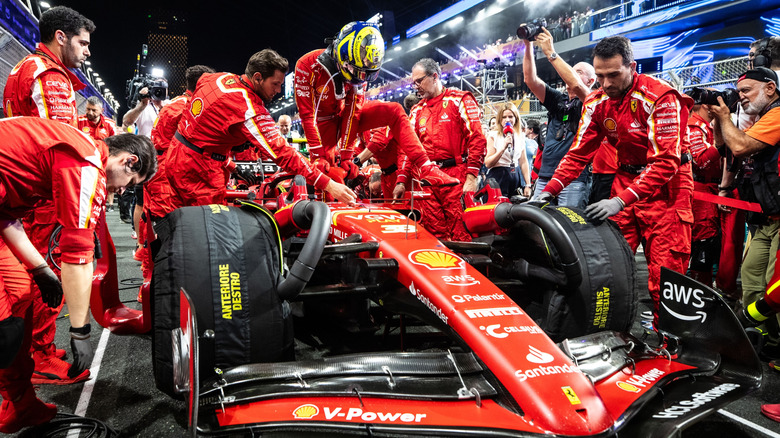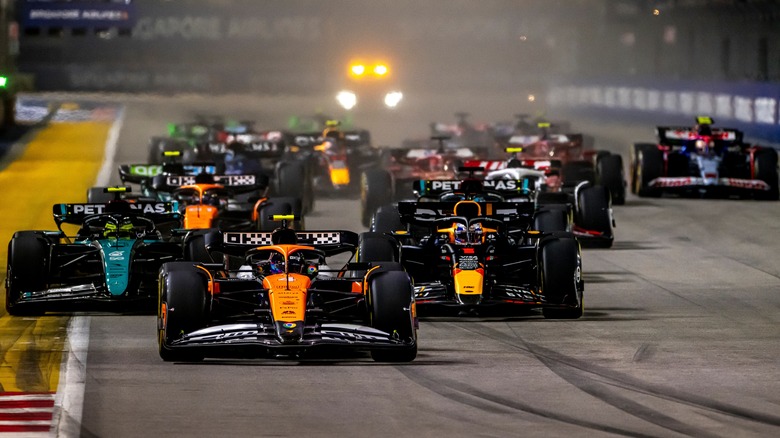How Much Fuel Do F1 Cars Use In A Single Race?
The modern F1 car is a technological and engineering marvel designed to compete in the very pinnacle of motorsport. However, with these cars, designers don't have free rein. They must all comply with a series of strict regulations as laid down by the F1's governing body — the Fédération Internationale de l'Automobile (FIA). These design rules cover everything from dimensions and weight to aerodynamics and safety. One of the most heavily legislated areas of design is the powertrains.
F1 made the shift from traditional engines to hybrid powertrains in 2014 (F1 engine regulations change again in 2026.) The move was designed to improve fuel efficiency in an age of growing environmental pressures. To achieve this, the current F1 engine is an incredible feat of hybrid engineering. Each F1 powertrain must follow the same template: a 1.6-liter V6 turbocharged engine with two electric motors and two Motor Generation Units (MGU) — the MGU-K and the MGU-H, more about these later. However, along with the introduction of the hybrid rules, the FIA also introduced strict legislation on the amount of fuel a car could carry and the flow rate that the fuel was allowed to be fed to the engine. The maximum fuel load allowed is 110 kilograms (about 37 gallons), and the fuel flow rate cannot exceed 100 kilograms per hour. As refueling isn't allowed, these figures represent the maximum fuel an F1 car will use in a race, but there are other factors to consider to get a clearer picture.
F1 hybrid era: A drive to efficiency
F1 has been using hybrid technology since 2011, when it first used the Kinetic Energy Recovery System (KERS) alongside batteries. However, this was more of a performance-boosting tool than an attempt to improve the environmental footprint of the sport. This aspect wasn't addressed until the introduction of the 2014 powertrain regulations. In terms of both performance and efficiency, these rule changes had an immediate effect. To understand this impact, it's useful to look at their 2.4 liter V8 predecessors. These engines had a simple hybrid system (KERS) and could produce about 850 hp, for comparison the V6-hybrid setup produces around 1,000 hp and burns a third less fuel over an average race distance.
How they achieved this is something that can only be considered an incredible piece of engineering. A simple breakdown of the hybrid components gives us an idea of how it all works. The beating heart of the system is a V6 1.6 liter turbocharged engine, which produces about 840 hp. The missing horsepower comes from the electrical components of the powertrain — the aforementioned MGU-H and MGU-K. The MGU-H recovers energy from the turbo's hot exhaust gases and stores it as electricity, which can then be used to spin the turbo and eliminate lag during acceleration. The MGU-K recovers energy during braking that would normally be lost as heat, stores it in a battery, and can then use that energy to boost the car's acceleration. Let's have a closer look at how all this technology translates into fuel consumption.
How F1 teams make every drop count
Formula 1 races are won or lost on tight margins, with even the fastest F1 cars striving to shave even a few hundredths of a second from lap times. One way that they can achieve this is by how much fuel they put in the car. While they are restricted to 110 kgs, teams are not compelled to "top her up" for a race. Teams will calculate just how much fuel the car will need to get to the end of the race with a bare minimum left in the tank (there must be at least a liter left to allow the FIA to take a sample). This isn't just a simple calculation like the car's average burn rate over the race distance either. Teams will frequently factor in things like potential safety cars, weather conditions, and getting the driver to "lift and coast" to reduce fuel consumption.
A common practice is to short-fuel by 5-15 kilograms to gain a performance edge from the reduced weight. What this means is that over a typical Grand Prix length of around 190 miles, an F1 car will usually burn between 95 -110 kilograms of fuel (or about 32 to 37 gallons). While that might not sound efficient, it's a remarkable achievement when you consider the speed, power, and complexity of modern F1 machinery — proof that performance and efficiency can go hand in hand. If you're new to the wonders of F1, then check out everything you need to know about Formula 1 racing guide.


